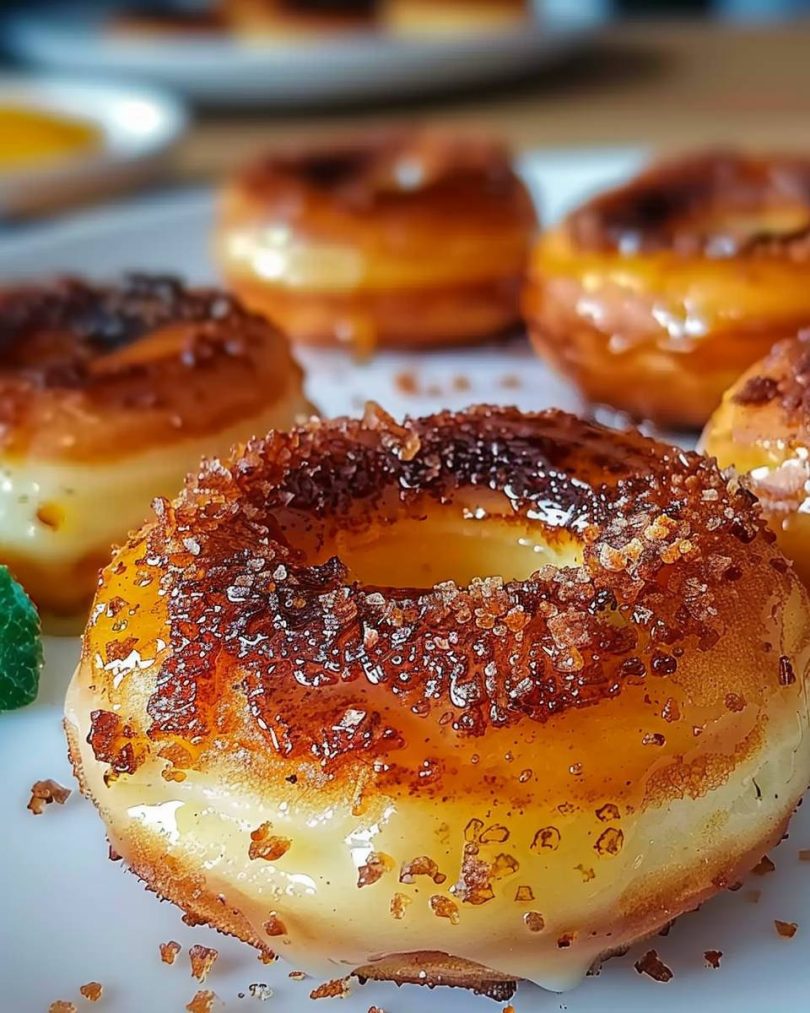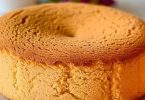Crème Brûlée Donuts: A Delightful Fusion of Classic Desserts
The Allure of Crème Brûlée Donuts: An Introduction
Crème Brûlée Donuts represent a delightful culinary innovation that marries the soft, airy texture of traditional donuts with the rich, creamy custard and caramelized sugar topping of classic Crème Brûlée. This dessert is a testament to the creativity of modern pastry chefs who strive to combine different elements from well-loved desserts into a single, irresistible treat. These donuts are typically characterized by:
A fluffy, yeast-raised donut base.
A smooth and creamy custard filling, infused with vanilla or other flavorings.
A hard caramel shell that cracks satisfyingly when tapped with a spoon or bitten into.
Ideal for a luxurious brunch or a decadent snack, Crème Brûlée Donuts have quickly risen in popularity, capturing the hearts of dessert enthusiasts who appreciate their unique combination of textures and flavors. The appeal of these donuts lies in their ability to provide a multi-sensory eating experience: the visual appeal of their glossy, caramelized tops, the soft texture of the donut, the creamy richness of the custard, and the contrasting crunch of the brûlée topping.
Sweet Origins: The Historical Journey of Donuts
Donuts, or doughnuts as they are alternatively spelled, have a fascinating history that spans several centuries and cultures. The modern donut as we know it today has evolved through many iterations:
The origins of donuts are often traced back to the Dutch settlers who brought with them a recipe for “olykoeks,” or oily cakes, in the early 19th century to America.
An important development in donut history was the purported invention of the donut hole. Legend has it that in 1847, Hanson Gregory, a young sailor, was dissatisfied with the uncooked centers of his donuts. He reportedly punched a hole in the center of the dough prior to frying, which led to the creation of donuts with perfectly cooked edges and centers.
During World War I, donuts were popularized in America by the Salvation Army, who set up donut tents in France to provide fresh donuts to US soldiers, earning the volunteers the nickname “Doughnut Dollies.”
Crème Brûlée: A Culinary Classic Through Time
Crème Brûlée, also known as “burnt cream,” is a dessert consisting of a rich custard base topped with a contrasting layer of hard caramel, often created by torching a coating of sugar. The dessert’s origins are debated but here are a few highlights:
The earliest known recipe for Crème Brûlée appeared in François Massialot’s 1691 cookbook, signaling its French origins. However, there are claims from both England and Spain for earlier versions of similar desserts.
In Spain, a similar dessert known as ‘Crema Catalana’ dates back to the 14th century. It differs mainly in that it is traditionally flavored with cinnamon and lemon zest.
Crème Brûlée gained renewed popularity in the 1980s as part of the rise of French cooking in the United States, often associated with upscale dining.
A Match Made in Dessert Heaven: The Unique Combo of Donut & Crème Brûlée
The combination of donut and Crème Brûlée into a single dessert creates a unique and highly favored treat due to several reasons:
Textural Contrast: The smooth custard and the crackly caramel provide a delightful contrast to the soft, pillowy dough of the donut.
Flavor Harmony: The buttery richness of the donut complements the vanilla and caramel flavors of Crème Brûlée.
Innovative Appeal: This fusion appeals to those who enjoy classic desserts with a modern twist, making it a standout choice in bakeries and cafes.
This unique blend of taste and texture makes Crème Brûlée Donuts not just a novel treat but a new classic in the making, appealing to both traditionalists and culinary adventurers alike.
Mastering the Art of Crème Brûlée Donuts: Ingredients and Preparation
Ingredients Overview
To create the perfect Crème Brûlée Donuts, you will need the following ingredients:
Dough Ingredients:
1 cup milk, lukewarm
1 tablespoon active dry yeast
1/3 cup granulated sugar
3 egg yolks
1 teaspoon vanilla extract
4 tablespoons unsalted butter, softened
4 1/4 cups all-purpose flour
1 1/2 teaspoons salt
Vegetable oil for frying
Custard Filling:
1/2 cup granulated sugar
1/2 teaspoon salt
3 tablespoons cornstarch
2 cups milk
4 egg yolks
2 teaspoons vanilla extract
2 tablespoons unsalted butter
Brûlée Topping:
1 cup granulated sugar
1/4 cup water
These ingredients are crucial for achieving the soft, pillowy texture of the dough, the rich, creamy filling, and the crisp, caramelized topping that characterize Crème Brûlée Donuts.
Step-by-Step Instructions
Creating Crème Brûlée Donuts involves several key steps that must be followed carefully to ensure success:
Preparing the Dough:
Activate the Yeast:
Combine the lukewarm milk, yeast, and a teaspoon of sugar in a large mixing bowl. Allow the mixture to sit for about 10-15 minutes until it becomes foamy, indicating that the yeast is active.
Mix the Dough Ingredients:
Add the egg yolks and vanilla extract to the yeast mixture, stirring well to combine.
In the bowl of a stand mixer fitted with a dough hook, combine the flour, remaining sugar, butter, and salt.
Pour in the yeast mixture and mix on low speed until the ingredients are just combined, then increase to medium speed and knead until the dough is smooth and elastic, about 5-10 minutes.
First Rise:
Transfer the dough to a lightly greased bowl, cover with plastic wrap or a clean kitchen towel, and let it rise in a warm, draft-free place for 1-2 hours or until doubled in size.
Making the Custard:
Prepare the Custard Base:
In a medium bowl, whisk together the sugar, salt, and cornstarch.
Beat the egg yolks until smooth, then gradually mix in the dry ingredients until the mixture is pale yellow and smooth.
Heat the milk in a saucepan over medium-high heat just until it starts to simmer. Gradually temper the hot milk into the egg mixture, stirring continuously to prevent the eggs from scrambling.
Cook the Custard:
Return the mixture to the saucepan and cook over medium heat, stirring constantly, until the custard thickens and begins to bubble.
Remove from heat and stir in the vanilla extract and butter until the custard is smooth.
Transfer the custard to a bowl, cover with plastic wrap pressed directly onto the surface to prevent a skin from forming, and refrigerate until cool.
Frying and Assembling the Donuts:
Shape and Fry the Donuts:
Punch down the risen dough and turn it out onto a lightly floured surface. Roll the dough to about 1/2-inch thickness.
Use a 3-inch cookie cutter to cut out rounds. Place these on a prepared baking sheet, cover, and let them rise again until puffed, about 20-30 minutes.
Heat the vegetable oil in a deep fryer or large pot to 360°F. Fry the donuts in batches until golden brown, about 1-2 minutes per side. Remove and drain on paper towels.
Fill and Finish with Brûlée:
Fill a piping bag with the custard and inject each donut.
For the brûlée topping, cook the sugar and water in a saucepan until golden. Dip the top of each filled donut into the caramel, then allow to set until hard.
These detailed steps will help you achieve perfect Crème Brûlée Donuts that are sure to impress with their delicious complexity and gourmet flair.
Baking vs. Frying Crème Brûlée Donuts: Techniques Compared
When making Crème Brûlée Donuts, the method of cooking—whether baking or frying—can significantly affect the outcome in terms of texture, flavor, and overall healthiness. Here’s a detailed look at the pros and cons of each method and what changes if you opt to bake instead of fry:
Pros of Frying:
Texture: Frying creates a crispy exterior and a soft, airy interior that is hard to replicate with baking.
Flavor Depth: The process of frying adds a unique depth of flavor to the donuts, enhancing the richness of the dough.
Speed: Frying is generally faster than baking, as it quickly cooks the donuts to a perfect golden brown within minutes.
Cons of Frying:
Health Concerns: Frying involves using a lot of oil, which can increase the caloric intake and fat content of the donuts.
Mess and Safety: Frying can be messy and hazardous due to the hot oil, requiring careful handling to avoid burns and spills.
Pros of Baking:
Healthier Option: Baking requires significantly less oil, making it a healthier option as it reduces the fat content of the donuts.
Ease and Safety: Baking is generally easier and safer than frying, with less active cooking time and no handling of hot oil.
Cons of Baking:
Texture Differences: Baked donuts often have a bread-like texture, which might not be as satisfying as the crispy exterior and soft interior created by frying.
Flavor Variance: Baking can sometimes result in a less flavorful donut compared to the rich taste achieved through frying.
Recipe Adjustments for Baking:
If you decide to bake your Crème Brûlée Donuts instead of frying, several adjustments need to be made to ensure they still turn out delicious:
Dough Preparation: The dough should be slightly wetter, as the dry heat of the oven can dehydrate the dough quickly.
Baking Temperature and Time: Preheat your oven to 375°F (190°C). Baked donuts generally take about 10-12 minutes in the oven. Keep an eye on them to ensure they don’t overbake and dry out.
Surface Moisture: To help mimic the crispy exterior typical of fried donuts, brush the dough rounds lightly with melted butter or oil before baking. This will help achieve a golden color and add some crunch.
Adjusting for Rise and Texture: Baked donuts might not rise as much as fried ones. Ensure your yeast is very active and give the dough ample time to proof to maximize rise.
Finishing Touches: Once baked, while still warm, you might want to brush them again with melted butter and dip in sugar or apply your brûlée topping as usual. This extra step will add moisture and flavor, enhancing the overall appeal of the baked donuts.
Choosing between baking and frying depends on your preference for texture, flavor, and health considerations. Both methods can produce delightful Crème Brûlée Donuts, each with its own unique characteristics and appeal.
Expert Techniques and Variations for Perfect Crème Brûlée Donuts
Troubleshooting Yeast Issues
Dealing with yeast in recipes can be tricky, especially for beginners. Yeast is a living organism, and its activity can greatly affect the rise and texture of your Crème Brûlée Donuts. Here are some tips to help troubleshoot common yeast-related issues:
Expired Yeast: Always check the expiration date on your yeast packet. Expired yeast can result in dough that does not rise.
Proper Activation: Yeast needs to be activated before it can help your dough rise. Mix the yeast with lukewarm water or milk (around 110°F; too hot can kill the yeast, too cold can inhibit its activity). Look for a foamy layer forming at the top, which indicates that the yeast is active.
First Rise Failure: If your dough doesn’t rise during the first proofing, the environment might be too cold. Find a warm spot without drafts, or turn your oven to the lowest setting, turn it off, and place the dough inside to rise.
Rapid Rise Yeast: If using rapid rise yeast, reduce the rising time, as this yeast acts faster than active dry yeast. Adjustments in the proofing time can prevent overproofing, which leads to dough collapsing.
Understanding these factors and how they affect yeast performance can help ensure that your dough rises perfectly every time.
Adjusting Dough Texture and Frying Tips
The texture of the dough and the frying process are crucial for achieving the perfect Crème Brûlée Donuts. Here are some advanced tips for managing dough texture and frying:
Dough Consistency: The dough should be soft and slightly sticky. If it’s too dry, add a tablespoon of milk or water at a time until you reach the desired consistency. If it’s too sticky, gradually add more flour, a tablespoon at a time.
Kneading: Proper kneading develops the gluten in the flour, which gives the donuts their structure. Knead the dough until it’s smooth and elastic.
Frying Temperature: The oil should be consistently heated to 360°F. Use a thermometer to monitor the temperature, as oil that’s too hot will burn the donuts, and too cool will make them greasy.
Batch Frying: Don’t overcrowd the fryer. Fry a few donuts at a time to ensure they cook evenly and the oil temperature stays stable.
Following these tips will help you achieve a superior texture both in the dough and the final fried donuts.
Recipe Variations
Experimenting with different flavors and ingredients can bring exciting twists to your Crème Brûlée Donuts. Here are two delicious variations:
Chocolate Hazelnut Crème Brûlée Donuts:
Fill: Mix chocolate hazelnut spread into the custard for a rich, chocolatey flavor.
Topping: After dipping in caramel, sprinkle chopped toasted hazelnuts for extra crunch and flavor.
Lemon Coconut Crème Brûlée Donuts:
Fill: Add lemon zest to the custard for a citrusy punch.
Topping: Mix shredded coconut into the sugar before creating the caramel topping. The coconut will toast as the sugar caramelizes, offering a delightful texture and tropical flavor.
These variations can cater to different taste preferences and make your donut-making experience even more rewarding.
Gluten-Free and Low-Carb Options
For those looking to enjoy Crème Brûlée Donuts but need to adhere to specific dietary requirements, here are some adaptations:
Gluten-Free Options:
Flour Substitute: Use a gluten-free all-purpose flour mix that includes xanthan gum, which helps mimic the texture of gluten.
Adjust Liquids: Gluten-free flours often absorb more liquid, so you might need to adjust the amount of milk or water in the recipe.
Low-Carb Options:
Flour Substitute: Replace traditional flour with almond flour or coconut flour, which are lower in carbs but will give a different texture.
Sugar Substitute: Use a sugar alternative like erythritol for the custard and caramel to reduce the carb content.
Adapting these recipes to fit gluten-free or low-carb diets allows more people to enjoy Crème Brûlée Donuts without compromising on taste or texture.
Storing and Showcasing Crème Brûlée Donuts: Best Practices and Stylish Serving Tips
Storing and Reheating Tips
Proper storage and reheating are essential to maintaining the quality and taste of your Crème Brûlée Donuts. Here are the best practices to ensure your donuts remain delicious:
Cooling Down: Allow the donuts to cool completely before storing. This prevents condensation inside the container, which can make the donuts soggy.
Room Temperature Storage:
Store in an airtight container to keep them fresh.
Place a sheet of parchment paper between layers of donuts to prevent them from sticking together.
Donuts stored at room temperature are best eaten within 24 hours.
Refrigerating:
For longer storage, refrigerate the donuts in an airtight container.
They can be kept for up to 3 days, but be aware that the texture of the brûlée topping may change.
Reheating:
To revive the donuts, lightly heat them in a microwave for about 10 seconds. This softens the donut but may not crisp the brûlée topping.
Alternatively, for a crispy brûlée topping, place under a broiler for a few seconds until the sugar bubbles and hardens again.
Following these steps will help maintain the integrity of your donuts for enjoyable consumption after storage.
Creative Presentation and Serving Ideas
Presenting and serving Crème Brûlée Donuts in a visually appealing manner can enhance the overall dining experience. Here are some creative ideas to showcase these gourmet treats:
Individual Serving Plates:
Serve each donut on a small, elegant plate with a dusting of powdered sugar and a drizzle of caramel or chocolate sauce.
Donut Tiers:
Construct a tiered donut stand for events, allowing guests to pick their favorite flavors.
Accompaniments:
Pair the donuts with complementary beverages such as gourmet coffee, espresso, or dessert wines.
Offer a variety of dipping sauces, like raspberry coulis or warm chocolate ganache, for an interactive eating experience.
Decorative Elements:
Use edible flowers, such as violets or rose petals, to add color and sophistication to the presentation.
Sprinkle the donuts with edible gold leaf pieces for a luxurious touch.
Seasonal Themes:
Adapt the presentation style to fit seasonal events, using themed decorations for holidays or special occasions.
These creative ideas not only enhance the visual appeal but also add a touch of elegance to the serving of Crème Brûlée Donuts, making them a standout at any gathering.
Essential FAQs: Everything You Need to Know About Crème Brûlée Donuts
Delving into the intricacies of making and enjoying Crème Brûlée Donuts raises many questions. Here’s a comprehensive FAQ section designed to address the most common inquiries with high SEO readability:
What is the best oil for frying Crème Brûlée Donuts?
Neutral Oils: Use oils with a high smoke point and neutral flavor, such as vegetable oil, canola oil, or peanut oil. These ensure that your donuts cook thoroughly without absorbing unwanted flavors.
How can I prevent the custard from curdling?
Tempering the Eggs: Gradually increase the temperature of the egg yolks by adding a small amount of the hot milk to the yolks before combining everything back into the pot. This method prevents the eggs from scrambling.
Constant Stirring: Keep the mixture moving in the pan to distribute the heat evenly and avoid hot spots that could cook the egg too quickly.
Can Crème Brûlée Donuts be made ahead of time?
Prepping in Advance: You can prepare the dough and custard a day in advance. Keep the dough covered in the refrigerator and the custard in an airtight container to prevent a skin from forming.
Frying: It’s best to fry the donuts the day they will be served to maintain the best texture and flavor of the brûlée topping.
What are some tips for achieving the perfect brûlée topping?
Even Caramelization: Use a torch to evenly melt and caramelize the sugar on top of the custard-filled donuts. This technique allows you to control the amount of heat applied and avoid burning the sugar.
Sugar Type: Granulated sugar works best for achieving a crisp, evenly melted crust. Superfine sugar can also be used for a thinner, more delicate crust.
How do you ensure the donuts are evenly cooked when frying?
Maintaining Oil Temperature: Keep the oil consistently heated to 360°F (182°C). Use a cooking thermometer to monitor the temperature.
Don’t Overcrowd: Fry the donuts in small batches to ensure they cook evenly and the oil temperature does not drop.
What variations can I make to the Crème Brûlée Donut recipe?
Flavor Infusions: Infuse the custard with different flavors such as espresso, cinnamon, or orange zest for a unique twist.
Dietary Adjustments: Substitute the all-purpose flour with gluten-free flour or replace the sugar with a keto-friendly sweetener for dietary needs.
Are there any tips for storing leftover Crème Brûlée Donuts?
Airtight Storage: Store any leftover donuts in an airtight container at room temperature for up to 24 hours. For longer storage, refrigerate for up to 3 days.
Reheating: Briefly warm refrigerated donuts in the microwave or oven to refresh the texture before serving.
Can I bake the donuts instead of frying them?
Baking Option: Yes, you can bake Crème Brûlée Donuts at 375°F (190°C) for about 10-12 minutes. While baking will result in a different texture, it is a healthier option.
Adjustments Needed: When baking, brush the dough rounds with melted butter before and after baking to help achieve a golden color and add moisture.
In the journey of exploring the delightful world of Crème Brûlée Donuts, we’ve traversed through various aspects from their rich history to intricate preparation techniques. Each element, whether it’s the perfect fry or the ideal custard consistency, plays a crucial role in crafting a donut that’s not just a treat but an experience. The versatility of these donuts allows for creative experimentation with flavors and presentations, making each batch a new opportunity to delight and impress. As we wrap up, remember that the key to perfect Crème Brûlée Donuts lies in the details—meticulous attention to the temperature of your oil, the quality of your ingredients, and the precision in timing are what set apart the average from the extraordinary.
Now that you’re equipped with the knowledge and techniques to make your own Crème Brûlée Donuts, why not take this inspiration into your kitchen? Gather your ingredients, embrace the culinary challenge, and prepare to dazzle your family, friends, or patrons with these gourmet treats. Whether you’re baking or frying, infusing new flavors, or sticking to the classic, the creation of Crème Brûlée Donuts is an adventure in itself. And if you’ve enjoyed this guide, or have any queries or suggestions, don’t hesitate to reach out or share your experiences. Your feedback and stories are what help us grow and improve. So, don your chef’s hat, preheat your oven or get that oil sizzling, and embark on your Crème Brûlée Donut journey. Happy cooking, and even happier indulging!






